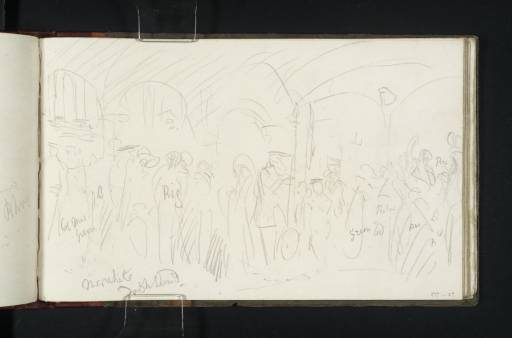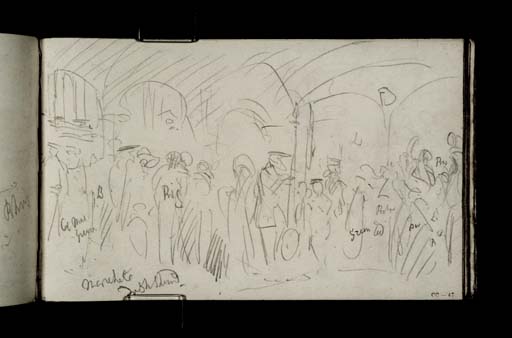Joseph Mallord William Turner The Peers' Ball at the Assembly Rooms, Edinburgh 1822
Image 1 of 2
Joseph Mallord William Turner,
The Peers' Ball at the Assembly Rooms, Edinburgh
1822
Joseph Mallord William Turner 1775–1851
Folio 47 Recto:
The Peers’ Ball at the Assembly Rooms, Edinburgh 1822
D17585
Turner Bequest CC 47
Turner Bequest CC 47
Pencil on white wove paper, 114 x 187 mm
Inscribed by Turner in pencil ‘B | col M[...] | Green’ left, ?‘Marchute | Irish [?]Stand’ bottom left, ‘Red S’ centre left, ‘Purple | Green [...] pink | p’ lower right centre, ‘Red’ right centre
Faint sign of John Ruskin’s red ink inscription ?‘47’ bottom right
Stamped in black ‘CC 47’ bottom right
Inscribed by Turner in pencil ‘B | col M[...] | Green’ left, ?‘Marchute | Irish [?]Stand’ bottom left, ‘Red S’ centre left, ‘Purple | Green [...] pink | p’ lower right centre, ‘Red’ right centre
Faint sign of John Ruskin’s red ink inscription ?‘47’ bottom right
Stamped in black ‘CC 47’ bottom right
Accepted by the nation as part of the Turner Bequest 1856
References
1909
A.J. Finberg, A Complete Inventory of the Drawings of the Turner Bequest, London 1909, vol.I, p.611, CC 47, as ‘An interior, with a crowd of figures.’.
1975
Gerald Wilkinson, Turner’s Colour Sketches 1820–34, London 1975, p.23 reproduced in black and white.
1981
Gerald Finley, Turner and George the Fourth in Edinburgh 1822, exhibition catalogue, Tate Gallery, London 1981, pp.84, [153] reproduced as ‘A social gathering, possible held in the interior of the addition build onto the Assembly Rooms, George Street, for the special ball held on 23 August in honour of the King’.
Gerald Finley has identified this sketch, and another on folio 48 (D17587), as showing the Ball given in King George IV’s honour on 23 August 1822. This was the Peers’ Ball (also referred to by Sir Walter Scott as the ‘Highland Ball’) – the Caledonian Hunt Ball was held on the 26th – to which Scott, in his Hints, stipulated that ‘no gentleman is to be allowed to appear in anything but the ancient Highland costume’.1 This explains the mixture of men in highland dress and women in eveningwear. It may also account for the double page of studies and notes of highland costume and accessories on folios 44 verso– 45 (D17580–D17581).
Although the setting does not match any of the spaces in the Assembly Rooms, in which both balls were held, Finley has noticed that is it accords with Robert Mudie’s description and diagram of the great supper room:
a temporary wooden building erected in the court-yard behind, extending from the second ball-room, the windows of which (the sashes being taken out) formed the doors of the new room.2
The extension was polygonal, and ‘designed like a tent’, with strips of muslin falling from a chandelier in the centre of the ceiling to the ‘slender pillars’ that supported it. The folds of cloth can be seen at the upper centre of the drawing, converging at the top of one of the pillars.
Although the crowd appear to stand in a concaved semicircle, a shape that the arches seem to follow, this may actually be the inner rather than the outer wall of the space. The outer polygon was lined with tables, and was decorated with a trompe-l’oeil of Scottish scenery by Mr Roberts, scene painter of the Royal Theatre, neither of which are in evidence. Furthermore, it is possible to see through the first and second arches at the left to a room beyond into which the crowd appears to be filing (see folio 48).
Turner has captured the sense of excited commotion with this crowd scene. Although individual figures are only roughly delineated, characteristic features such as bonnets, tartan, shields and ball gowns can be discerned, and inscriptions add further details (see also folio 46 verso; D17584).
The sketch on folio 48 shows a crowd of people around the arch at the left of the present picture. They appear to be filing through the archway.
Composition ‘7’ of the ‘Royal Progress’ cycle plan may represent this scene, although several other possibilities have also been put forward (King at Edinburgh sketchbook inside back cover; Tate D40980).
Thomas Ardill
September 2008
How to cite
Thomas Ardill, ‘The Peers’ Ball at the Assembly Rooms, Edinburgh 1822 by Joseph Mallord William Turner’, catalogue entry, September 2008, in David Blayney Brown (ed.), J.M.W. Turner: Sketchbooks, Drawings and Watercolours, Tate Research Publication, December 2012, https://www


